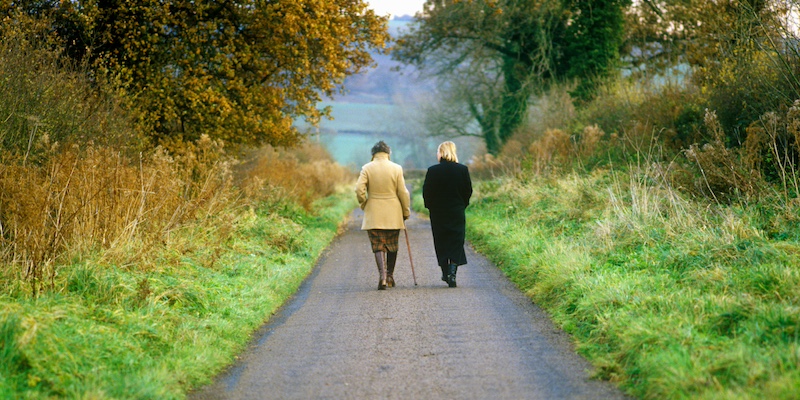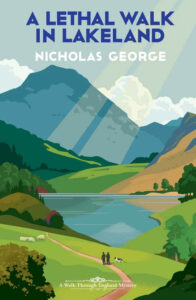For cleansing one’s mind and reconnecting with nature, there’s nothing like a calming walk in the pastoral splendor of the English countryside. Normally, it’s a safe and carefree experience—unless you’re in one of my Walk Through England mysteries. In that case, watch out! Danger can lurk behind every tree, around every bend, and even in the warm confines of a country pub.
If you’re thinking of joining a group walk in England, here are some tips to ensure you won’t end up on a slab beneath the local medical examiner’s magnifying glass:
Always check your boots. Walking boots are large and sturdy enough to hide an array of unpleasant surprises if you step into them without looking inside first. Why would you look into your boots, you ask? You won’t be asking again if you encounter a deadly adder ready to bite. (Adders’ venom is generally not fatal, but do you want to take that chance?) Other “surprises” can include poison-tipped tacks or vicious scorpions. (I hope I’m not giving would-be murderers any ideas!)
Don’t stand near the edge of a cliff. This is good advice to heed pretty much all the time, even if there’s no murderer lurking nearby. A very popular English walk is along the “Seven Sisters” chalk cliffs in Sussex, particularly those that overlook the landmark lighthouse at Beachy Head. These cliffs soar more than 500 feet above the rocky shores below, so it’s no surprise that hundreds of people have lost their lives falling off the cliffs through the years, many of them suicides. Were some murders? It wouldn’t be surprising. If you do find your walking path getting uncomfortably close to the edge of a cliff, especially if you’re walking with someone who dislikes you, stay as far from the edge as possible, and make sure no one is walking behind you. If there’s a thick fog that blocks your vision, stop immediately! Don’t move again until it clears, either partially or fully, and when you can, move as far inland as possible.
Watch what you drink. One of the pleasures of walking in the English countryside, as I’ve mentioned, is the local pub. Typically, it’s a warm, thatch-roofed building filled with cozy nooks, a roaring fire, one or two sleeping hounds, and a tempting line-up of ale taps along the bar featuring the best of locally-brewed spirits. But never let that freshly-drawn pint of beer out of your sight! Pubs can easily become boisterous, rowdy places with a lot of activity (including dart-throwing; the combination of deadly, sharp projectiles and inebriated throwers can be deadly). Pub chaos makes it easy for a murderer to slip something nasty into your drink without being seen, where it immediately dissolves among the bubbles and foam.
The stairway can be treacherous. Britain’s castles are some of its most popular attractions. Who doesn’t relish seeing how famous kings and queens, whom today would be living in the utmost luxury, used to sleep in cold, stony cells, with no indoor plumbing, thermostat-controlled heating, or WiFi? And that’s not the half of it. Many castles have steep stone staircases and turret balconies, many without banisters and exposed to the elements. Refer back to my warning about avoiding paths near a cliffside: these are not locales you want to frequent if you’re a potential murder victim—especially if wet weather (a British staple) makes the stone surfaces slippery.
Never wear red. Sometimes it’s perfectly acceptable to wear red. If you’re dressing as the devil on Halloween, for example, or you’re marching in a Communist parade. But on a walking trail? Not smart. England’s trails and footpaths frequently cross private land, which often includes farms. Where there are farms, there are cows, and where there are cows, there are usually horn-equipped bulls. Bulls get angered at the color red (ever see a matador’s cape at a bullfight?) and will charge without hesitation. If you’re entering a field or pasture in which there’s a bull, you are usually notified by a posted sign saying something like “Caution: Bull in Field”. That’s your cue to remove your red rain slicker and stash it in your backpack. (If one of your walking companions takes that occasion to mention how good you look in red, don’t think twice. Avoid that person like the plague.)
Maybe you’re a-mazed. Another popular attraction in England are its garden mazes. These twisty corridors lined by tall hedges can be a diverting challenge (tip: always walk to the right—place your right hand on the hedge as you enter and keep it consistently touching throughout your journey). What makes garden mazes particularly challenging is that, unless you’re a star basketball player, you’re probably not tall enough to see the center of the maze (your goal). That also means you can’t be seen, as neither can that person sneaking up behind you with a stone, ready to cosh in your head. The solution? Either avoid garden mazes entirely, or walk with three or four others, preferably people you trust.
There are other things you may encounter on a British trail, and all of them have the potential to be used in nefarious ways by a resourceful killer. Therefore, be careful when encountering kissing gates, cattle grids, wall and fence stiles, river and creek crossings, and even statues (large ones can be toppled over to crush you). The thing is, how can you tell if a killer is nearby? That leads me to my last tip:
Know your walking partners. When on walking holidays, most of us go with close friends or family members. Presumably, we’d have an idea of whether they want to do us in long before we agree to take a long walk in the countryside with them. It’s not unusual, however, to join a walking group of complete strangers. In such cases, be sure your walk has been arranged by a reputable firm, and you are being led by a qualified guide. It is the guide’s job not only to lead you along the trail safely and securely, but to be on watch for any signs of trouble. In addition, get to know your fellow walkers. Walking together gives you plenty of time to get to know one another, and uncover any murderous intent.
After reading this, you might now consider walking in the English countryside as appealing as walking through a minefield. That was not my intent! Most people make it through an English walk not only unscathed, but anxious to return and do it again. Even as I write this, I picture myself joyfully ambling along a trail, relishing the steady movement of my arms and legs, anticipating the view around the next bend…
Wait. What was that sound behind me?
***


















